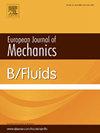Hydrodynamic force coefficients for spherical triangle shell fragments: Dependence on the aspect ratio and flatness
IF 2.5
3区 工程技术
Q2 MECHANICS
引用次数: 0
Abstract
Euler–Lagrange simulations of particle-laden flow require hydrodynamic models of drag and lift forces for individual particles. Our goal is to develop models that can prescribe these forces for arbitrarily orientated shell objects. Here, we use computational fluid dynamics simulations of steady bottom-boundary layer flow over a series of spherical triangle shell fragments to calculate the hydrodynamic forces. The simulations explicitly resolve the wall boundary layers using grid resolution on the order of at the shell fragment surface and use the SST k-omega turbulence closure model. These fragments cover a range of aspect ratio and flatness characteristics. The shell fragments are generated as triangular selections of a spherical shell with azimuthal and longitudinal angles proscribed based on elongation and flatness parameters (varying between 1 to 5, and 0.02 to 0.2 respectively), while characteristic length of the fragment is held constant to define the overall fragment size. Fragment orientations are considered with independently varying pitch, roll, and yaw each ranging from 0 to 180 degrees. The numerical estimates for the forces from all simulations were used to develop robust parameterizations of the drag and lift as a function of aspect ratio and flatness characteristics, as well as orientation of the shell fragments.
球形三角壳碎片的流体动力系数:取决于长宽比和平面度
载颗粒流的欧拉-拉格朗日模拟需要单个颗粒的阻力和升力的流体力学模型。我们的目标是开发能够为任意方向的壳体物体规定这些力的模型。在这里,我们利用计算流体动力学模拟一系列球形三角形壳体碎片上稳定的底部边界层流动,来计算流体动力。模拟明确解析了壳体碎片表面的壁边界层,网格分辨率为 y+=1,并使用 SST k-omega 湍流闭合模型。这些片段涵盖了一系列长宽比和平面度特征。生成的壳碎片是球壳的三角形选区,其方位角和纵向角根据伸长率和平整度参数(分别在 1 到 5 和 0.02 到 0.2 之间变化)进行限制,而碎片的特征长度保持不变,以定义整体碎片大小。片段方向考虑了独立变化的俯仰、滚动和偏航,每个方向的变化范围为 0 至 180 度。所有模拟的力的数值估计值都被用来开发阻力和升力的稳健参数,作为长宽比、平整度特征以及壳碎片方向的函数。
本文章由计算机程序翻译,如有差异,请以英文原文为准。
求助全文
约1分钟内获得全文
求助全文
来源期刊
CiteScore
5.90
自引率
3.80%
发文量
127
审稿时长
58 days
期刊介绍:
The European Journal of Mechanics - B/Fluids publishes papers in all fields of fluid mechanics. Although investigations in well-established areas are within the scope of the journal, recent developments and innovative ideas are particularly welcome. Theoretical, computational and experimental papers are equally welcome. Mathematical methods, be they deterministic or stochastic, analytical or numerical, will be accepted provided they serve to clarify some identifiable problems in fluid mechanics, and provided the significance of results is explained. Similarly, experimental papers must add physical insight in to the understanding of fluid mechanics.

 求助内容:
求助内容: 应助结果提醒方式:
应助结果提醒方式:


